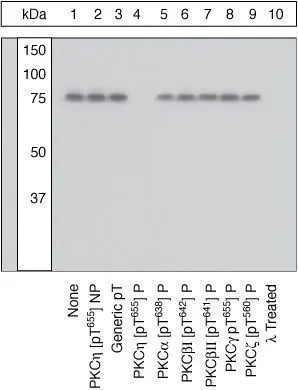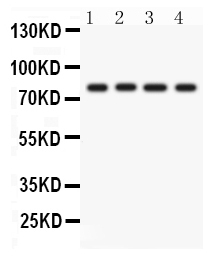
WB (peptide competition) analysis of Jurkat cells stimulated with PMA using GTX25798 PKC eta (phospho Thr655) antibody prior incubated with the non-phosphopeptide corresponding to the immunogen (Lane 2), a generic phosphothreonine containing peptide (Lane 3), the phosphopeptide immunogen (Lane 4), or the phosphopeptide corresponding to the immunogen from other PKC isoforms (Lane 5-9). The data show that only the immunogen phosphopeptide blocks the signal, demonstrating the specificity of the antibody. The membrane treated with phosphatase (Lane 10) eliminates the signal further verifying that the antibody is phospho-specific. Dilution : 1:2000
PKC eta (phospho Thr655) antibody
GTX25798
ApplicationsFlow Cytometry, Western Blot
Product group Antibodies
TargetPRKCH
Overview
- SupplierGeneTex
- Product NamePKC eta (phospho Thr655) antibody
- Delivery Days Customer9
- Application Supplier NoteWB: 1:2000. FACS: 1:20. *Optimal dilutions/concentrations should be determined by the researcher.Not tested in other applications.
- ApplicationsFlow Cytometry, Western Blot
- CertificationResearch Use Only
- ClonalityPolyclonal
- ConjugateUnconjugated
- Gene ID5583
- Target namePRKCH
- Target descriptionprotein kinase C eta
- Target synonymsPKC-L, PKCL, PRKCL, nPKC-eta, uORF2, protein kinase C eta type, Protein uPEP2
- HostRabbit
- IsotypeIgG
- Protein IDP24723
- Protein NameProtein kinase C eta type
- Scientific DescriptionProtein kinase C (PKC) is a family of serine- and threonine-specific protein kinases that can be activated by calcium and the second messenger diacylglycerol. PKC family members phosphorylate a wide variety of protein targets and are known to be involved in diverse cellular signaling pathways. PKC family members also serve as major receptors for phorbol esters, a class of tumor promoters. Each member of the PKC family has a specific expression profile and is believed to play a distinct role in cells. The protein encoded by this gene is one of the PKC family members. It is a calcium-independent and phospholipids-dependent protein kinase. It is predominantly expressed in epithelial tissues and has been shown to reside specifically in the cell nucleus. This protein kinase can regulate keratinocyte differentiation by activating the MAP kinase MAPK13 (p38delta)-activated protein kinase cascade that targets CCAAT/enhancer-binding protein alpha (CEBPA). It is also found to mediate the transcription activation of the transglutaminase 1 (TGM1) gene. Mutations in this gene are associated with susceptibility to cerebral infarction. [provided by RefSeq, Sep 2015]
- Storage Instruction-20°C or -80°C,2°C to 8°C
- UNSPSC12352203
References
- Lee PC, Kumar V, Sivakumar G, et al. Development of triazole-based PKC-inhibitors to overcome resistance to EGFR inhibitors in EGFR-mutant lung cancers. Am J Cancer Res. 2023,13(10):4693-4707.Read this paper





